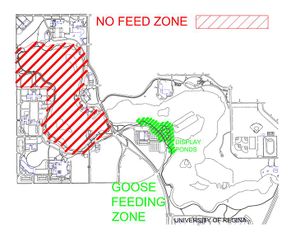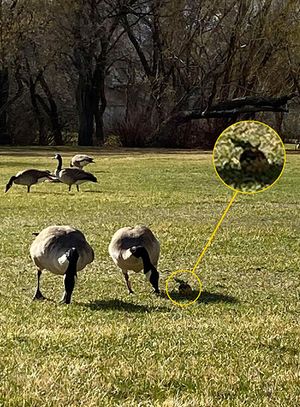Goose Cakes: Difference between revisions
No edit summary |
|||
| Line 38: | Line 38: | ||
===Recipes=== | ===Recipes=== | ||
Goose Cupcake | |||
Success: 2/10 | |||
- grass (blended) | |||
- raspberries (whole) | |||
- arugula | |||
- vegan suet | |||
Revision as of 17:53, 5 July 2020
Introduction
"This project began somewhere in the early weeks of the COViD-19 pandemic’s initial surge in North America. I’d gone back to Saskatchewan to self-isolate, and after about a week or so it dawned on me that the only other ‘people’ that I’d really spent time with other than my partner were the Canada geese that populate Wascana Lake, Regina’s man-made water feature that dominates much of the central and southern parts of the city. The apartment that I was staying at was near a large nesting ground (sleeping area? Hangout?) for the geese, and every morning at around 5 am the two of us would awaken from the distant honking overhead. A chorus that once unconsciously signaled the arrival of spring in the backdrop of day-to-day life had, in the absence of ‘activity’, or ‘life’, as I usually understood it, bubbled to the surface of my recognition.
This was one of the odd side-effects on social life that the pandemic seemed to have had on cities throughout the world. In the quietude of empty streets emerged birdsong, animals from the surrounding area, and common ‘pests’ like rats in search of human waste that had suddenly disappeared.[1] The geese in Regina, however, arrive perennially. It was as though, rather than witnessing a re-emergence, it was instead my attention to detail that changed. Locked away inside (like most others who have the privilege of doing so) my daily walks became requisite for the maintenance of my own sanity. And, in my moments of boredom between anxiety, I started to notice more than did before: I walked across the frozen lake in March, and took note of the way the top of the ice sheet gradually melted in the day before freezing again at night. I observed the daily patterns of my neighborhood geese, who gathered nearby in the mornings before flying to a bay across the lake to rest at night. I stood and watched as the flock, hundreds large, organized smaller groups that marched in unison before flying away, like peeling an orange in sections. I watched the geese throw their necks up in a flailing stretch and beat their wings against their bodies. I tried to recognize their different types of honks, hisses, and mumbles, and wondered about their relationships.
As the spring unfolded, the geese spread from their initial icy landing pad. The single large flock dispersed in search of slowly greening grass in the surrounding municipal park, and they began nesting eggs in the goose-specific islands in the southeast portion of the lake: Goose Island and Tern Island, in the Wascana Lake Migratory Bird Sanctuary.
The coexistence of the animals in the sanctuary (among them, Mallards, Sandpipers, Black Tern, three varieties of Grebe, Pelicans, Loons, and Beavers, to name a few[2]) has a tinge of strange irony to me. The lake itself is entirely artificial, and only exists because of the damming of Wascana Creek in 1883. As a self-described (small) city kid, it never really dawned on me that the lake could inhabit that much life, and, quite honestly, be that beautiful. Citizens of Regina will be familiar with the common trope that Wascana Lake is really more of a goose toilet bowl than it is a source of clean fresh water. In fact, the smell emanating from the lake got so bad in the early 2000s that it spawned a city project, the ‘Big Dig’[3], to deepen it and improve the flow of oxygen. Over the last few years, yet another ungainly tradition: the die-off of invasive carp, whose large bodies sometimes float to the surface in the thousands after the ice melt because their oxygen is cut off during the winter freeze-over.[4] Wascana Lake’s unfortunate reputation has even spawned satires like Swamp Fest, an annual music festival whose lore features the mascot T. A. B. (Toxic Algae Blob), a creature borne out of Wascana’s mysterious and poisonous waters.[5] Given this history, my newfound fascination with the lake as a genuinely picturesque biodiverse ecology was something of a surprise.
This surprise spurred me to get to know the geese on a more intimate level. So, as they unfurled their wings and began to feed, I planned a gift for them in conversation with Rowan and the rest of the What You See crew. Vegan suet, it turns out, is commonly used as a binding agent to make three dimensional shapes out of bird seed, so I made plans to make goose cupcakes, a decorated cupcake made from seed and other goose-friendly foods.
For whatever reason, though, the geese didn’t like the cupcake at all. They completely ignored it in favor of the plentiful grass that surrounded them."
Locations
Wascana Park, Regina
"Lorem ipsum dolor sit amet, consectetur adipiscing elit, sed do eiusmod tempor incididunt ut labore et dolore magna aliqua. Ut enim ad minim veniam, quis nostrud exercitation ullamco laboris nisi ut aliquip ex ea commodo consequat. Duis aute irure dolor in reprehenderit in voluptate velit esse cillum dolore eu fugiat nulla pariatur. Excepteur sint occaecat cupidatat non proident, sunt in culpa qui officia deserunt mollit anim id est laborum."

High Park, Toronto
"Lorem ipsum dolor sit amet, consectetur adipiscing elit, sed do eiusmod tempor incididunt ut labore et dolore magna aliqua. Ut enim ad minim veniam, quis nostrud exercitation ullamco laboris nisi ut aliquip ex ea commodo consequat. Duis aute irure dolor in reprehenderit in voluptate velit esse cillum dolore eu fugiat nulla pariatur."
On Goose/Human Relations
On Goose Diet

Recipes
Goose Cupcake Success: 2/10
- grass (blended) - raspberries (whole) - arugula - vegan suet